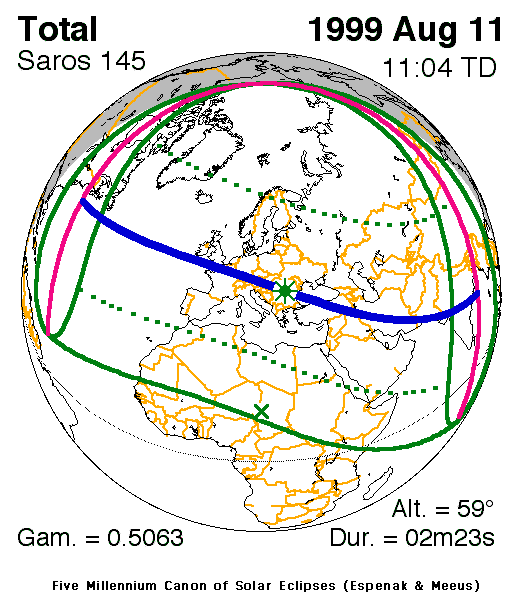| Object : | Sun & Moon |
| Object size : | 0.5 degree each |
| Object magnitude : | - |
| More to know : |
Wikipedia:
https://en.wikipedia.org/ wiki/ Sun
https://en.wikipedia.org/ wiki/ Moon
|
| Object : | Sun and Moon
|
| Date : | 1999 11 August |
| Time (UT) : | 09:35 to 12:00 |
| Mount : | EQ4, motor |
| Lens/telescope : |
MTO Rubinar 4" 1000 mm f/10 to project on a matte screen |
| Corrector/Barlow : | Konica50 mm f/1.7 (f/16) 35 mm camera lens, reversed for macro photographing |
| Filter : | none |
| camera : | Konica T3 |
| Film/CCD : | Kodak PJ 400 |
| Exp. time : | 0.001 seconds |
| Weather : | some clouds |
| Comment : |
At Stockholm where I was it's not a total eclipse, about 70%.
Several sunspots are visibly, they are the grey dots on the Suns surface.
Each is of comparable size as the Earth.
The Sun are 400 times farther away than the Moon and the size of Sun is also 400 times the Moon so they looks to have the same sizes.
They both cover an angle of 0.5 degree. |
| Object : | Sun and Moon
|
| Date : | 1999 11 August |
| Time (UT) : | 09:35 to 12:00 |
| Film/CCD : | Kodak PJ 400 |
| Exp. time : | 30 x 0.001 seconds |
| Comment : |
30 photos taken 5 minutes apart and put together to a time lapse movie.
Because Stockholm is on a too high Latitude the Sun and Moon don't line up perfect.
At lower latitudes, example at Hungary they line up.
But at that place it was clouds and heavy rain, my friends were there. |
| More to know : |
Wikipedia:
https://en.wikipedia.org/ wiki/ Solar eclipse
https://en.wikipedia.org/ wiki/ Saros (astronomy)
https://www.heavens-above.com/ SolarEclipses.aspx
|

 Credit:
NASA
Credit:
NASA